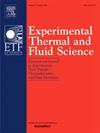Dynamics and interactions of counter-rotating waves in rotating detonation combustors
IF 2.8
2区 工程技术
Q2 ENGINEERING, MECHANICAL
Experimental Thermal and Fluid Science
Pub Date : 2025-04-16
DOI:10.1016/j.expthermflusci.2025.111486
引用次数: 0
Abstract
Better understanding of non-canonical modes such as counter-rotating wave dynamics provides valuable insights for future rotating detonation engine injector design and combustion mode control. The objective of this work is to study the dynamics and interactions of counter-rotating waves in an RDC experimentally. Previous experimental and numerical data suggest that at collision points, the resulting pressure amplitude is not necessarily the result of a linear combination between the waves, but rather a more complex interaction. In this study, we analyze temporally resolved, high-speed pressure and luminosity data for two counter-rotating waves propagating at equal (2CR) and different (2CRT) speeds. This analysis employs a soft-dynamic time warping averaging scheme, which preserves the shape of the data even in the presence of lap-to-lap fluctuations. From this analysis, the non-linear pressure and luminosity interaction at collision is quantified over the wave lap and for different geometries and operating conditions. Notably, it is found that the strength of the non-linearity at collision is mode dependent and increases as one wave becomes stronger relative to the other one. Furthermore, a one-dimensional gas dynamics model is applied to capture wave collisions in an RDC. The model captures the counter-rotating wave interaction in the 2CR mode, indicating that these waves behave like shock waves. However, in the 2CRT mode, the model underestimates the collision pressure, suggesting that additional mechanisms contribute to the nonlinear interaction between the counter-rotating waves.
旋转爆轰燃烧室中逆旋波的动力学与相互作用
更好地理解非规范模式,如反旋转波动动力学,为未来旋转爆震发动机喷油器设计和燃烧模式控制提供了有价值的见解。本工作的目的是通过实验研究RDC中反向旋转波的动力学和相互作用。以往的实验和数值数据表明,在碰撞点,产生的压力振幅不一定是波之间线性组合的结果,而是更复杂的相互作用。在这项研究中,我们分析了两个反向旋转波在相同(2CR)和不同(2CRT)速度下传播的时间分辨、高速压力和光度数据。该分析采用了一种软动态时间扭曲平均方案,即使在存在圈对圈波动的情况下也能保持数据的形状。从这一分析中,在不同的几何形状和操作条件下,对碰撞时的非线性压力和光度相互作用进行了量化。值得注意的是,发现碰撞时的非线性强度与模态有关,并且随着一个波相对于另一个波变得更强而增加。在此基础上,建立了一维气体动力学模型来捕捉RDC中的波碰撞。该模型在2CR模式下捕获了反向旋转波的相互作用,表明这些波的行为类似于激波。然而,在2CRT模式下,模型低估了碰撞压力,这表明反旋转波之间的非线性相互作用有额外的机制。
本文章由计算机程序翻译,如有差异,请以英文原文为准。
求助全文
约1分钟内获得全文
求助全文
来源期刊

Experimental Thermal and Fluid Science
工程技术-工程:机械
CiteScore
6.70
自引率
3.10%
发文量
159
审稿时长
34 days
期刊介绍:
Experimental Thermal and Fluid Science provides a forum for research emphasizing experimental work that enhances fundamental understanding of heat transfer, thermodynamics, and fluid mechanics. In addition to the principal areas of research, the journal covers research results in related fields, including combined heat and mass transfer, flows with phase transition, micro- and nano-scale systems, multiphase flow, combustion, radiative transfer, porous media, cryogenics, turbulence, and novel experimental techniques.
 求助内容:
求助内容: 应助结果提醒方式:
应助结果提醒方式:


